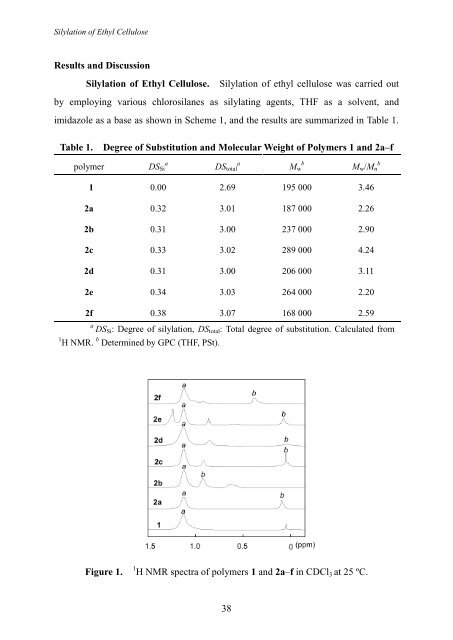Synthesis, Characterization, and Gas Permeation Properties
Synthesis, Characterization, and Gas Permeation Properties
Synthesis, Characterization, and Gas Permeation Properties
You also want an ePaper? Increase the reach of your titles
YUMPU automatically turns print PDFs into web optimized ePapers that Google loves.
Silylation of Ethyl Cellulose<br />
Results <strong>and</strong> Discussion<br />
Silylation of Ethyl Cellulose. Silylation of ethyl cellulose was carried out<br />
by employing various chlorosilanes as silylating agents, THF as a solvent, <strong>and</strong><br />
imidazole as a base as shown in Scheme 1, <strong>and</strong> the results are summarized in Table 1.<br />
Table 1. Degree of Substitution <strong>and</strong> Molecular Weight of Polymers 1 <strong>and</strong> 2a–f<br />
polymer DSSi a DStotal a Mw b Mw/Mn b<br />
1 0.00 2.69 195 000 3.46<br />
2a 0.32 3.01 187 000 2.26<br />
2b 0.31 3.00 237 000 2.90<br />
2c 0.33 3.02 289 000 4.24<br />
2d 0.31 3.00 206 000 3.11<br />
2e 0.34 3.03 264 000 2.20<br />
2f 0.38 3.07 168 000 2.59<br />
a DSSi: Degree of silylation, DStotal: Total degree of substitution. Calculated from<br />
1 H NMR. b Determined by GPC (THF, PSt).<br />
Figure 1. 1 H NMR spectra of polymers 1 <strong>and</strong> 2a–f in CDCl3 at 25 ºC.<br />
38

















